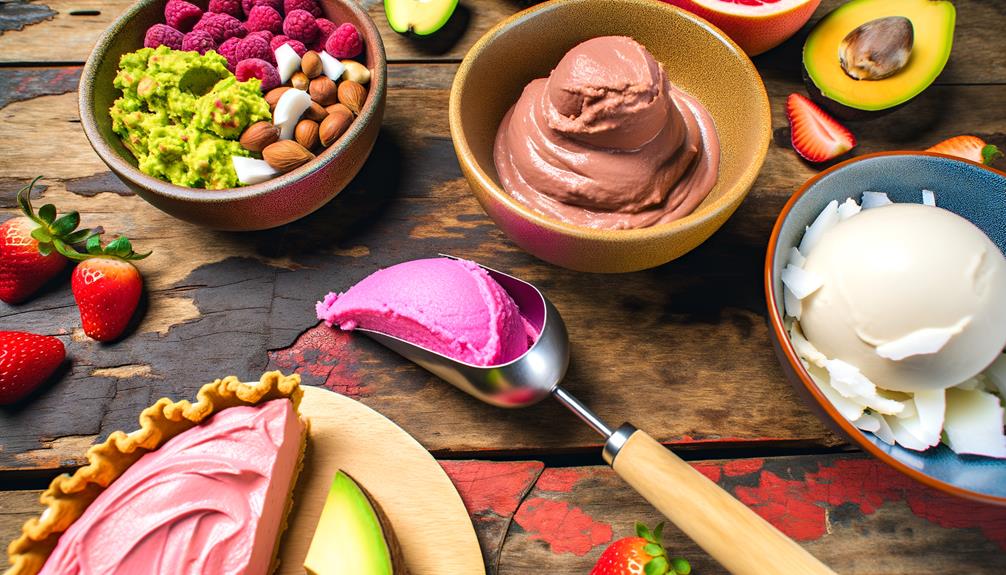Did you know that Aquafaba, the liquid leftover from cooked chickpeas, can be whipped into a foam with a consistency remarkably similar to egg whites? It’s just one of the innovative techniques you can use to elevate your vegan desserts to new heights. As you navigate the world of plant-based sweets, you’ll uncover a cornucopia of flavors and textures you never thought possible within the constraints of a vegan diet. From mastering the art of vegan meringue to experimenting with vegan-friendly frostings, these eight techniques will enable you to create desserts that are as delicious as they are compassionate. So, why not take a little culinary adventure? By the end of this journey, you might find yourself wondering why you didn’t start baking vegan desserts sooner.
Key Takeaways
- Aquafaba, the liquid leftover from cooked chickpeas, can be whipped into a foam and used as a replacement for egg whites in vegan desserts.
- Vegan sugar substitutes, such as mashed vegan banana or applesauce, maple syrup, agave nectar, and coconut sugar, can be used in place of traditional sugar.
- Creamy vegan fillings can be made using soaked cashews or coconut milk as a base, with the addition of ripe avocados, natural sweeteners like maple syrup or Medjool dates, and thickeners like arrowroot powder or agar-agar.
- Vegan-friendly frostings can be made using ingredients like vegan butter, powdered sugar, almond milk, cocoa powder (for chocolate frosting), maple syrup, coconut cream, and vanilla extract. Different frostings can be used to enhance the flavor of various desserts.
Embracing Aquafaba in Vegan Baking
Dive into the world of vegan baking with aquafaba, the light-as-air liquid from canned chickpeas, that can revolutionize your egg-free desserts by creating a moist and fluffy texture. Embracing aquafaba in vegan baking is embracing a world of easy vegan desserts that can truly compete with their non-vegan counterparts.
Imagine whipping up the best vegan desserts with simple ingredients already in your pantry. You could be making vegan meringues, macarons, even marshmallows with a food processor and a can of chickpeas. When whisked, aquafaba forms stiff peaks and acts as a binder in recipes, effortlessly replacing eggs in your vegan cakes and cookies.
Don’t forget to drain and strain the liquid from the chickpeas for optimal results. Combine it with vegan butter to achieve a creamy texture that’s to die for in any vegan dessert. Your vegan chocolate cake could be the next sensation, fluffy, moist, and absolutely delicious.
With aquafaba, you’re not just substituting, you’re innovating. You’re using wholesome ingredients to create treats that everyone can enjoy. So go ahead, experiment with aquafaba and discover the magic it can bring to your vegan baking. You’re serving not just food, but joy and inclusivity, one dessert at a time.
Perfecting Vegan Sugar Substitutes
While aquafaba can elevate your egg-free desserts, the right choice of vegan sugar substitutes can truly take your sweet treats to the next level, adding nuanced flavors and maintaining the much-loved texture found in traditional desserts. The art of perfecting vegan sugar substitutes can be a game-changer in crafting the best vegan dessert recipes.
Here are four tips to consider:
- Utilize natural sweeteners like mashed vegan banana or applesauce, perfect for moist and flavorful vegan brownies or simple cookies.
- Experiment with maple syrup, agave nectar, or coconut sugar for a delicious vegan twist.
- Consider vegan cream cheese sweetened with stevia or monk fruit for a Vegan Gluten-Free Carrot Cake.
- Adjust the liquid ratio when using liquid sweeteners. This ensures your sweet treat maintains its desired texture.
Creating Creamy Vegan Fillings
To whip up luscious, creamy vegan fillings for your desserts, consider using soaked cashews or coconut milk as the base. These natural, whole food ingredients give a rich, velvety texture that’s perfect for any cream filling. For a delectable twist, you can blend in ripe avocados. The subtle flavor complements a variety of desserts, from vegan apple pies to chocolate tarts.
To sweeten your creamy vegan filling, opt for maple syrup or Medjool dates. These natural sweeteners add a touch of sweetness without overpowering the creaminess. Plus, they contribute essential nutrients, making your desserts not just tasty, but also wholesome.
If you’re aiming for a thicker consistency, incorporate natural thickeners like arrowroot powder or agar-agar. Just a spoonful can transform your coconut cream into a silky, spoonable delight. For a chocolatey touch, mix in some cocoa powder. It pairs wonderfully with coconut oil, creating a rich and indulgent vegan filling.
And don’t forget to experiment! Try adding coconut yogurt for tanginess, or create a vegan ice cream filling for a refreshing twist. With these tips, your vegan desserts will be a hit at any gathering.
Techniques for Vegan-Friendly Frostings
Crafting a velvety vegan frosting might seem like a culinary challenge, but with the right ingredients and techniques, you’ll find it’s a piece of cake. Vegan-friendly frostings are simple to make and can transform any dessert into a sweet, rich treat.
- Vegan Vanilla Frosting: Vegan butter, powdered sugar, and almond milk create a smooth, creamy frosting. It’s ideal for a vegan vanilla or chocolate cake.
- Chocolate Frosting: By adding cocoa powder to the Vegan Vanilla base, you’ll whip up a rich, decadent chocolate frosting that’s perfect for any dessert.
- Maple Frosting: Switch out the powdered sugar for maple syrup for a unique, naturally sweet frosting. It pairs beautifully with an autumn-themed dessert.
- Vegan Ice Cream: Coconut cream, your choice of sweetener, and a dash of vanilla extract make a rich, creamy vegan ice cream. Add in some frozen fruit for a refreshing twist.
Mastering Vegan Gelatin Alternatives
Dive deep into the world of vegan gelatin alternatives, like agar-agar, carrageenan, and agar powder, to unlock a treasure trove of delightful vegan desserts. Mastering vegan gelatin alternatives is key to creating your favorite vegan dishes that are gluten-free.
Imagine crafting a rich and creamy vegan ice cream using agar-agar, a gelatin substitute derived from seaweed. Its unique properties help deliver that desired consistency, making your dessert a sweet treat that’s both indulgent and animal-friendly.
Then picture whipping up a batch of your much-loved Chocolate Chip Cookie Dough using carrageenan, another seaweed-derived gelatin alternative. This ingredient, also used in dairy-alternative products, provides the chewy texture you crave.
Don’t forget about Vegan Lemon Bars, a dessert that’s tart and sweet. Agar powder can give these bars their firm yet smooth texture. Experiment with these alternatives and find the right balance for your desserts.
Lastly, vegan fudge is a classic favorite. By replacing traditional gelatin with a vegan alternative, you can create a dessert that’s decadently rich and creamy.
Essential Tips for Vegan Pastry
Having explored the wonders of vegan gelatin alternatives, let’s now turn our focus to the art of vegan pastry making, an equally exciting aspect of plant-based dessert creation.
Creating vegan pastries is a delightful culinary journey that allows you to serve others with delicious, compassionate treats. Here are a few essential tips:
- Substitute wisely. Use coconut oil or vegan butter for a flaky pastry crust. Switch out eggs for mashed bananas or applesauce for binding and moisture.
- Flour Power. Whole wheat flour and nut flours like almond or coconut add a depth of flavor and texture that’s both nutritious and satisfying.
- Sweeten naturally. Maple syrup, coconut sugar, or date syrup can enhance the sweetness of your pastries without refined sugars.
- Experiment with flavors. Chocolate chips, cacao powder, lemon juice, and vanilla extract can add an innovative touch to your pastries.
Vegan Chocolate Baking Techniques
Let’s delve into the rich world of vegan chocolate baking techniques, where a hint of creativity can turn simple dairy-free milk and dark chocolate into a divine, creamy dessert experience. Experiment with various alternative sweeteners to satisfy your sweet craving while adhering to vegan guidelines. Maple syrup, agave nectar, or coconut sugar can be the perfect sweet companions for your Dark Chocolate creations.
Incorporate unique ingredients like applesauce, mashed bananas, or ground flaxseeds as egg substitutes to maintain moisture and binding in your vegan chocolate baking. With just a handful of ingredients, you can whip up a rich chocolate dessert that’s not only delectable but also vegan-friendly.
Consider avocado, coconut cream, or silken tofu for that luscious texture in your vegan ice cream or chocolate ganache. A splash of brewed coffee or espresso powder can enhance the depth of chocolate flavor, making it the best easy technique to elevate your vegan dessert game.
Lastly, don’t forget to sprinkle some cacao nibs on top for that extra crunch. These vegan chocolate baking techniques require no more than four ingredients at a time, but they promise a universe of flavor in every bite.
The Art of Vegan Meringue
Continuing our sweet journey, we now turn our attention from the rich depths of vegan chocolate to the light, airy artistry of vegan meringue. This delicate dessert can satisfy your sweet tooth and is a perfect topping for your vegan ice cream or vanilla cake.
- Start by getting your ingredients. They’re easy to make with items you likely already have: aquafaba from a can of chickpeas from the grocery store, sugar, and cream of tartar.
- Pour the aquafaba into a large bowl and start whisking with a stand mixer. Once it’s foamy, add the cream of tartar.
- Gradually add sugar while continuing to whisk. You’re aiming for a glossy mixture with stiff peaks – the hallmark of a good meringue.
- Bake at a low temperature for a crispy outside and a fluffy and tender inside.
Whether you’re making whipped cream or a meringue-topped dessert, this technique ensures you’ll serve a treat that’s as lovely to look at as it is to eat.
Frequently Asked Questions
What Makes a Baked Good Vegan?
You’re making baked goods vegan by swapping out animal products. Use egg substitutes, dairy alternatives, and vegan sweeteners. Explore options like vegan puddings, raw desserts, and baked fruit desserts for variety and flavor.
What Is the Hardest Dessert to Make?
You’ll find complex soufflés, difficult macarons, and tricky tiramisu to be among the hardest desserts to make. Other challenging ones include croquembouche, delicate éclairs, and the laborious Pithiviers. It’s all about precision and patience.
Why Are Vegan Desserts Better?
You’ll find vegan desserts superior due to their health benefits, allergen friendly options, and cruelty-free ingredients. Enjoy the taste difference with vegan chocolate, dairy substitutes, and sugar alternatives while appreciating their eco-friendly and nutritional value.
What Are Vegan Desserts Made Of?
You’re making vegan desserts with plant-based milk, vegan chocolate, and sweeteners like date paste. You’re using coconut cream, tofu, cashew cream and agar agar. Your crusts are nut-based, and you’re ditching gelatin for vegan substitutes.







